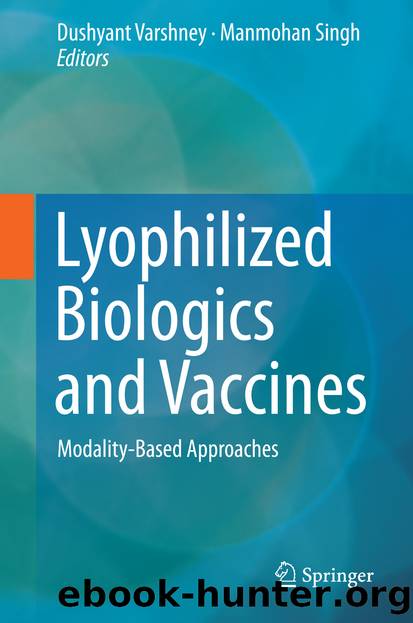Lyophilized Biologics and Vaccines by Dushyant Varshney & Manmohan Singh

Author:Dushyant Varshney & Manmohan Singh
Language: eng
Format: epub
Publisher: Springer New York, New York, NY
Systems Considerations
There are several other elements of the process and equipment design that, when looked at as an end-to-end process, have the potential to significantly impact the quality and consistency of transferred process. One example is the choice of lyophilizer door design, often related to the decision to accommodate automated vial loading. Commercial lyophilizers are in use with standard, side-hinged, full doors that enable access to the entire chamber from top to bottom as well as slot-style “pizza” doors that only expose a few shelves at a time and are most amenable to automated loading. Differences in the loading and shelf indexing approach used in these systems should be considered from a standpoint of operational ease and efficiency as well as compatibility with intended product types. For example, the product warming associated with multiple openings of a standard lyophilizer door and multiple shelf indexing steps was found to result in unintended and variable product annealing for a labile live virus product transferred to the lyophilizer in prefrozen vials [74]. While not a standard industry process, this example highlights how small operational choices, such as the lyophilizer loading and indexing procedure, can influence final product quality outcomes.
The extent of process automation to pursue should balance total system cost, consistency, and flexibility. While manual and automated systems can both deliver high quality products, there are some considerations to keep in mind both for the transition from laboratory to production scale as well for routine production-scale operation where automation is concerned. First, many activities that were performed manually during laboratory development will be automated in a standard production line. One example of this is the automated partial stoppering of vials that occurs on filling lines. Drying cycles should be designed to be robust to the typical line setup variability and resulting small differences in stopper position.
Second, the implementation choices for automating a process can have unexpected consequences for supply chain management and process validation . For example, a sample that was easy to obtain for a manually loaded and unloaded process at laboratory or production scale may be very difficult to obtain for an automated process. If nonstandard supplemental samples are expected to be required as part of process validation activities or potential manufacturing deviation resolution, forethought should be given to the process for obtaining such samples, including alignment with existing media challenge interventions. The cause for such sample challenges can range from lack of human operators in the processing area where nonstandard samples would need to be collected to handling and subsequent automated transfer concerns caused by disruption of tray or shelf pack integrity. One example of unintended supply chain consequences is from an automation choice in a new facility that leveraged automated transfer carts for movement of vials in and out of the lyophilizer on a shelf by shelf basis. Although this system greatly streamlined certain operational steps and improved sterility assurance, it could only accommodate transfer of full shelves, equivalent to thousands of vials. Therefore, it was highly desirable to
Download
This site does not store any files on its server. We only index and link to content provided by other sites. Please contact the content providers to delete copyright contents if any and email us, we'll remove relevant links or contents immediately.
| Anatomy | Animals |
| Bacteriology | Biochemistry |
| Bioelectricity | Bioinformatics |
| Biology | Biophysics |
| Biotechnology | Botany |
| Ecology | Genetics |
| Paleontology | Plants |
| Taxonomic Classification | Zoology |
Sapiens: A Brief History of Humankind by Yuval Noah Harari(14250)
The Tidewater Tales by John Barth(12608)
Mastermind: How to Think Like Sherlock Holmes by Maria Konnikova(7227)
Do No Harm Stories of Life, Death and Brain Surgery by Henry Marsh(6889)
The Thirst by Nesbo Jo(6826)
Why We Sleep: Unlocking the Power of Sleep and Dreams by Matthew Walker(6618)
Life 3.0: Being Human in the Age of Artificial Intelligence by Tegmark Max(5474)
Sapiens by Yuval Noah Harari(5294)
The Longevity Diet by Valter Longo(5019)
The Body: A Guide for Occupants by Bill Bryson(4974)
The Rules Do Not Apply by Ariel Levy(4859)
The Immortal Life of Henrietta Lacks by Rebecca Skloot(4525)
Animal Frequency by Melissa Alvarez(4395)
Why We Sleep by Matthew Walker(4359)
The Hacking of the American Mind by Robert H. Lustig(4318)
Yoga Anatomy by Kaminoff Leslie(4305)
All Creatures Great and Small by James Herriot(4232)
Double Down (Diary of a Wimpy Kid Book 11) by Jeff Kinney(4207)
Barron's AP Biology by Goldberg M.S. Deborah T(4096)
